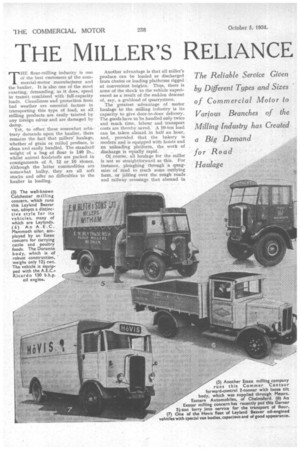THE MILLER'S RELIANCE
Page 44

Page 45

If you've noticed an error in this article please click here to report it so we can fix it.
on ROAD TRANSPORT
The Reliable Service Given by Different Types and Sizes of Commercial Motor to Various Branches of the Milling Industry has Created a Big Demand for Road Haulage
THE flour-milling industry is one of the best customers of the corn. mercial-motor manufacturer and the haulier. It is also one of the most exacting, demanding, as it does, speed in transit combined with full-capacity loads. Cleanliness and protection from bad weather are essential factors in transporting this type of load, as all milling products are easily tainted by any foreign odour and are damaged by
damp. .
Yet, to offset these somewhat arbitrary demands upon the haulier, there remains the fact that millers' haulage, whether of grain or milled produce, is clean and easily handled. The standard. weight of a bag of flour is 140 lb., whilst animal foodstuffs are packed in consignments of 8, 12 or 16 stones. Although the latter commodities are somewhat bulky, they are all soft stocks and oiler no difficulties to the haulier in loading.
Another advantage is that all miller's produce can be loaded or discharged from chutes or loading platforms rigged at convenient heights. Thus, there is none of the shock to the vehicle experienced as a result of the sudden descent of, say, a grabload of quarrystone.
The greatest advantage of motor haulage to the milling industry is its capacity to give door-to-door delivery. The goods have to be handled only twice and much time, labour and transport costs are thereby saved. A 10-ton load can be taken aboard in half an hour, and, provided that the bakery is modem and is equipped with hoists and an unloading platform, the work of discharge is equally rapid. .
O.( course, all haulage for the miller is not so straightforward as this. For instance, ploughing through a quagmire of mud to reach some outlying farm, or jolting over the rough roads and railway crossings that abound in dockland, are services calculated to test stability and engine power to the ut
most. Yet here, again, the motor scores over any other rival. Its extreme mobility enables it to penetrate to places beyond the scope of the railways, whilst its speed enables it to deliver the goods far ahead of any horse
drawn vehicle: .
Then there is the matter of return loads. Here the motor offers undoubted advantages, especially since the introduction of the English Wheat Quota Act. Now that a much greater quantity of the English farmer's wheat is required, the motor can pick up return loads from farms in close proximity to the destinations of outward deliveries,. Here is a direct saving to the Miller and an incentive to the motor haulier tO cater for this class of traffic.
The trailer, was at first looked upon by both millers and hauliers as an asset only to long-distance work. Now it has come into favour for short-distance traffic. -By using three trailers— one loading, one discharging, and one en route—the wastage of time thus caused on short hauls has been lessened appreciably. The economies effected by this method have brought the motor further into favour for dock and inland-warehouse work.
In the face of strong opposition, the motor has won for itself a position peculiarly its own in the milling industry. This it has achieved by sheer merit of service, coupled with a readiness to adapt itself to the needs of the industry. The modern miller, recognizing the trend of events, now uses road transport wherever practicable.
Other persons have alsO found that mechanical road transport has advantages that neither rail not canal possesses, and their decided• preference for the more accommodating form, of transit has given the miller much •.tei think about. These ,persons are most important to the miller ;.they are his customers. Bakers, provision mer
chants, corn factors, Offal dealers, and farmers are all turning to road transport, the speed and raobility of which have captured the custom of many consumers who formerly relied upon the rail and canal for conveyance.
It is now an everyday occurrence for a string of lorry drivers to call at a flour miller's office and present collection inStructions for anything up . to 20 tons of produce. • In such circumstances as these, it behoves the miller who would keep abreast of the times to be ever on the alert to itnprove his yard facilities.
Extra loading stages, chutes and hoisting tackle are all invaluable aids
in rapid handling Of goods, whilst the provision of a separate entrance and exit to and from the mill yard would obviate "much of the congestion that often occurs during a iesh period. The fact that many millers.have taken steps. to ,solve their yard traffic problems proves that mechanical road transport has won for itself the recognition that it deserves.




































































































